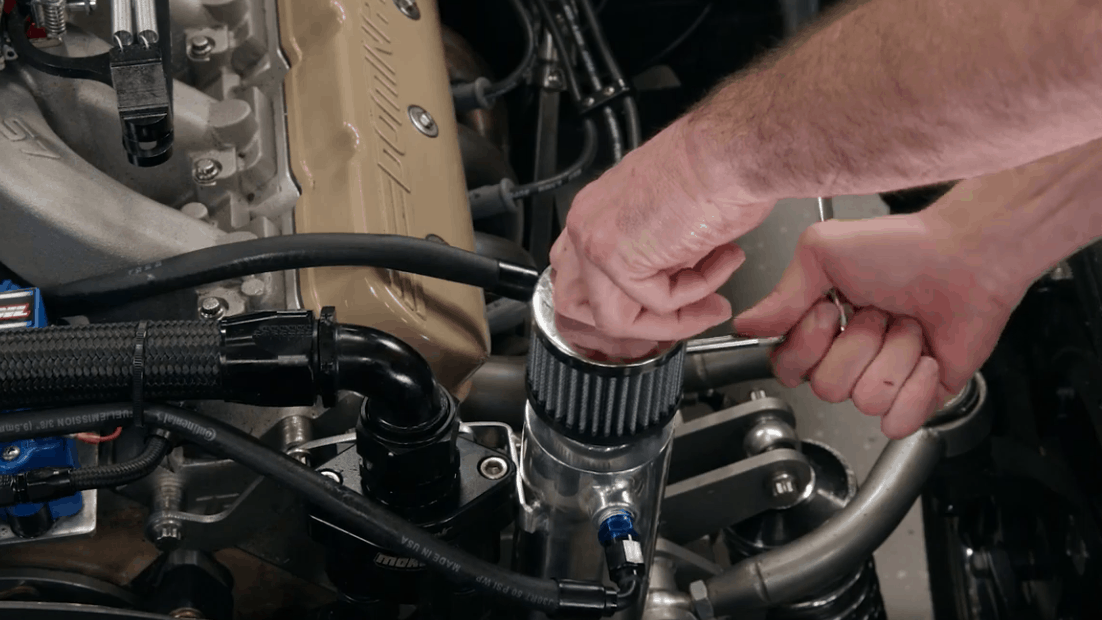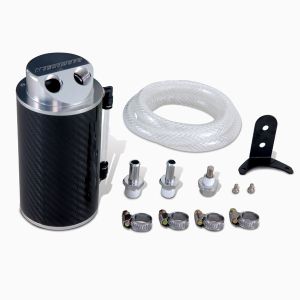

All fittings/hose/hose ends are for push lock hose, if you'd like something else please let us know. Our standard configuration is below, but we can modify the catch can to whatever size fittings you'd like! Our standard drain configuration is setup for the moroso oil pan, which has a 1/2NPT Fitting, please let us know if you are NOT using this pan as you will require different length lines and a different fitting arrangement. We also include two HPS Silicone caps for the throttle body. We keep the factory breather port of the valve cover returning to the intake via a -10 hose (you'll need to modify your intake tube or have us fabricate you one) The PCV chamber now vents into the can and is vented to atmosphere. The reason for this is particular, my car no longer is fuel injected, and instead uses carburetors, so the valve cover was disconnected - and in being so, oil would soil the engine bay. This is why we have a dual drain back system, keeping oil in your pan where it belongs! The catch can described in this article will sort of mimic the same principle, although the catch can will vent to open atmosphere. One of the pictures is of a customer who spent one day at the track (20 laps) and then drained his catch can just to see how much oil is being pushed out, needless to say they were shocked. These cans were designed as a "bolt in" for the 2zz swapped MRS, due to the camshaft lubrication design, there is a extreme amount of oil in the upper end of these motors. This can features a dual chamber design to keep the air flow separate from each other. The weak rod bolts would broke when the engine run at high rpm, it will. Unlike most catch cans on the market, we designed this to be BIG, air volume is key is keeping the oil out of the air. Connecting Rod Rods For Toyota Celica 2.0L 3SGTE 3S-GTE MR2 Turbo Conrods 138mm. To make the connections to the catch can you can use a push on fitting. This location allows easy access to the drain on the bottom of the can and gives you a nice path for the lines to follow from the vents. Our unique 3 stage baffling system does this job extremely well. The catch can will be mounted to the bracket that secures the remote thermostat housing in place. Measuring drained oil is an estimating function unless you weigh empty vessels (filter, rags, oil container, etc.) before and after and calculate with some.

Will keep ya posted.This catch can was designed with one thing in mind, strip the oil from the air the motor is spitting out and return it back to the oil pan where it belongs. (Within reason, dont take argument to extreme.) I will often get a tablespoon maybe 2 oil trapped in the catch can in 3k miles.

I would like to know if this is an effective solution for reducing gunk and wear and tear since this is basically the same engine that is in my son's 2000 MR2 Spider. It is the bank that the 4Runner parts are going to come from. I will see what I can do about testing this out but I do not intend on keeping this car too long. It turned out tight and neat and won't rot out like the old one. An old shelf bracket served that purpose. Had to create a bracket to mount it to the car. Instead of dropping fifty-five bucks on a new one, I used a gallon and a half gas tank from an old lawn mower for the job. Thinking About The Installation: There are a few different places where one can mount a catch-can in an MR2 Turbo. Finally, ring the lid with Teflon tape and hammer it on tight. For example, my windshield washer tank was rotten in this car. The liquid oil will stay in the can in any case, as long as the level of oil in the can doesn't get as high as the output fitting So that's the can complete. DIY and repurposing are what appeals the most to me. There are some videos floating around for some DIY versions as well. On the other hand, some are way too cheap.

Pricewise, some of these things are ridiculously over priced. Why return them to the engine? The biggest drawback is that these cans are maintenance intensive requiring monitoring during oil changes, an added step that some may not be willing to make. However, these vapors contain a lot of trash. Now, at least, I understand why this is and that it is nothing major. On my first examination of an intake system, I was surprised and worried about all of the oil and gunk that had accumulated there. I would not even consider removing the pcv valve but it is merely a check valve designed to take that back pressure off of the crank case and return those vapors to the intake.


 0 kommentar(er)
0 kommentar(er)
